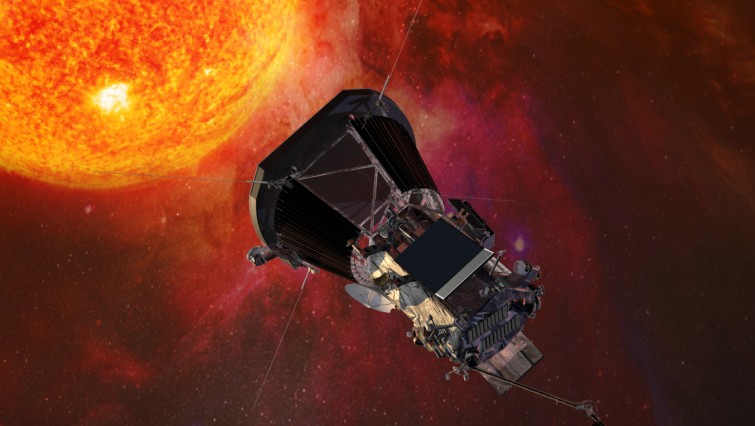
The Riddle of the Solar Wind
by Mathias Hüfner
In this universe, shaped by open and intercommunicating systems, we can discern countless forms of relationship and participation.
Papst Franziskus Laudato si’ 2015
For the first time, a spacecraft is on its way to fly through the atmosphere of our sun. This has a very practical background. Space weather has been observed daily for several years. Sun storms that hit our earth pose a serious threat to our power grids. The “Parker Solar Probe”, named after solar wind researcher Eugene Newman Parker, comes closer to it than any previous solar mission. The spacecraft launched on August 12, 2018. Over the next 7 years, it is expected to solve the puzzling behavior of our home star, moving closer to the sun over 6 million kilometers, which is scheduled for December 24, 2024 for the first time. That is a distance of approximately 8.5 sun radii. There are said to be 1400 degrees Celcius. This is far too hot for the materials previously used in space travel and that is why no such mission has yet been undertaken. Now, however, extreme sun approach with the latest technology should finally be possible.
The probe is said to solve two major puzzles in solar physics.
- How is it that the solar corona is a million degrees hot while the surface of the sun itself is just 5500 degrees?
- How does the constant stream of charged particles, the so-called solar wind, arise, which the sun hurls far beyond its planets to the edge of the solar system?
The common idea is that the sun would continuously launch a mixture of protons and electrons into space, thereby losing about a million tons of mass per second. Sarah Perdue from the University of Wisconsin-Madison on Phys.org1 made the following statement:
“With more negatively charged electrons streaming away, the sun takes on a positive charge. This makes it harder for the electrons to escape the sun’s pull. Some electrons have a lot of energy and keep traveling for infinite distances. Those with less energy can’t escape the sun’s positive charge and are attracted back to the sun. As they do, some of those electrons can be knocked off their tracks ever-so-slightly by collisions with surrounding plasma.“ And further “There is a fundamental dynamical phenomenon that says that particles whose velocity is not well aligned with the magnetic field lines are not able to move into a region of a strong magnetic field,” Boldyrev says. “Such returning electrons are reflected so that they stream away from the sun, but again they cannot escape because of the attractive electric force of the sun. So, their destiny is to bounce back and forth, creating a large population of so-called trapped electrons.”
Sarah Perdue
This explanation cannot be understood physically. Why should the sun continuously lose mass when gravity attracts all masses, and how should the electron reservoir be emptied again? The problem is that astrophysicists are adamant about the thesis that the sun is a thermonuclear furnace and that it draws its energy from the inside, a glowing hot gas ball made of hydrogen that slowly fuses to helium under great pressure. But this model cannot answer the two questions raised above. Especially since Parker2 said: “… No significant electric field can arise in the reference frame of the moving plasma.” The classic idea is that the cosmic plasma is quasi-neutral and there would be no potential differences in the cosmos. The divine order demands that the world be symmetrical and everything in balance, at least that is the Christian faith.
If permanent magnetic fields are present and masses, however, according to James C. Maxwell, currents must also flow and if currents flow, the cause of this is a potential difference. The cause of a potential difference is a battery or simply a double layer that gives the current a direction. A reference to the double layer can also be found in the above quotation from Perdue, by writing about the bouncing electrons.
The measurements of the solar probe of the DSCOVR system3, are in direct contradiction to Parker’s statement, – which reports an electrical current of about 3 – 6 protons / cm3 per day in calm sun. The speed of these protons near the earth is between 350 and 450 km / s. If there is such an electrical current, Maxwell’s equations apply to this current. The cause of an electric current is a potential difference between the sun and the earth and thus an electric field, and magnetic vortices form around this field, which are particularly visible in the polar regions of the earth as auroras. Such streams have been known as Birkeland streams since their confirmation by the space probes in 1959 after the Norwegian physicist Kristian Birkeland, who spent his life researching the northern lights in the last decade and later modeling them in the laboratory in the Terrella experiment.
Is the sun really losing mass? That is very much in doubt. The cosmos is not empty, as was believed a hundred years ago. There has been a lot of talk about dark matter in recent years. It is not exotic matter, but simply gas and dust between the stars in a finely distributed form. If you look at the optical spectra of galaxies, you will find emission lines between the stars as well as hydrogen and nitrogen and oxygen ions. The electrons must therefore be located elsewhere separately from these ions. This is an indication of further double layers in the galaxies.
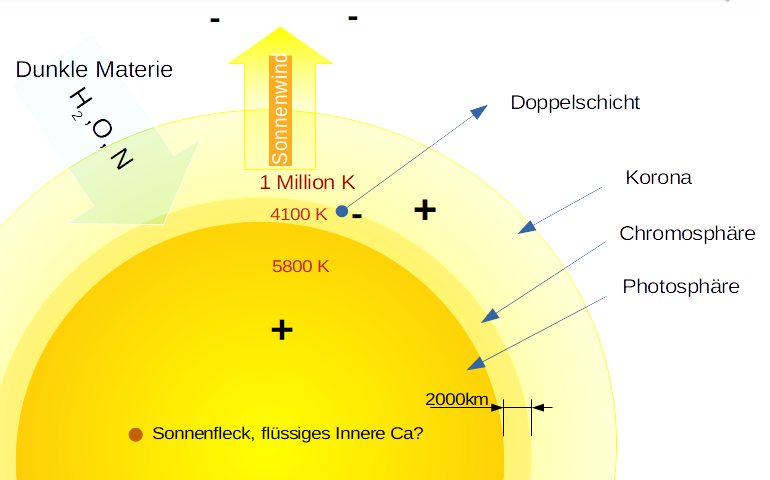
Ralph Juergens4 was the first to question the classic thermonuclear solar model as early as 1979 and to develop an electric solar model. This allowed him to identify the solar granulation as anode tufts. The electrical properties of the photosphere up to 800 km, the chromosphere up to 1900 km and the lower corona region, the visible boundary of the sun, are described in Juergens electric solar model as being dominated by a double layer of electric charge.
Double layers occur everywhere at phase transitions. The most typical application of a double layer is the storage battery, but thermocouples are also created on double layers of two different elements. I reported in the German journal Raum & Zeit, issue 3/2020 of the sun model SAFIRE5, what was created in the laboratory. Several double layers were observed there. Electric field strengths of 8,000 volts per meter occurred.
This double layer is responsible for the fact that positive ions are accelerated outwards from the sun’s surface, Donald Scott6 discovered. Positive ions do not suffer external electrostatic forces as long as they are in the photosphere. Only diffusion movements and accidental thermal movements should occur there. The temperature there is simply the measure of the violence of these random movements. The low surface temperature of the sun of ~ 5800 K is measured in the photosphere. In the chromosphere, the temperature drops slightly before then rising again. At the border between the chromosphere and the corona there is an area where the temperature suddenly rises to 1 million degrees and more. That is the area of the double layer. There the ions are strongly accelerated. But how can this be explained?
Perhaps one or the other reader can still remember the time when electronics were still touchable when tubes and transistors were still being used. An electronic component was the triode, with which you could build an amplifier for the radio receiver. It was an evacuated glass jar with three electrodes inside. A metal grid was installed between the cathode and the anode, which also acted as an electrode. A negative voltage could be applied there, so that only more or fewer electrons could get to the anode, the remaining electrons were forced to reverse on the grid, as they were repelled by the electrons on the grid. The electron flow from the cathode to the anode can be controlled by a voltage on the grid. The anode current is higher than the grid current – this is called an amplifier! The triode was the first electronic component that was used as an amplifier. It was an NNP transition that the electrons have to deal with.
The difference between the electron flow in the triode and the solar wind is that we have a hot anode (the sun) and a cold cathode. In addition, the cathode is a virtual one and is huge compared to the anode, since it covers practically the entire heliopause. The transition is a PNP transition, but no protons emerge from the anode, as would be assumed after Hans Heinrich Voigt’s Digest of Astronomy7. There, three basic types of solar wind are described on page 153:
- The fast solar wind 500-800km / s from coronal holes, characteristic of inactive sun
- The slow solar wind 250-400 km / s from sources over the active areas of the sun
- Coronal mass ejections
The systematic recording of the solar wind from spaceweather.com goes back to the year 2001. For January I have determined the average speed of the solar wind over the whole of January from the daily mean values and its standard deviation and shown in the figure. I projected sunspot activity from above from the same source.
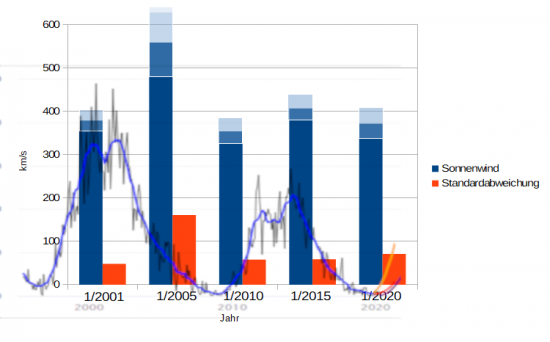
The results must be interpreted in such a way that one cannot differentiate between fast and slow solar winds according to their origin. Only in the case of high sunspot activity does the speed appear to increase sharply for a short time as a result of the frequently occurring flares on the double layer, and the particle density of the solar wind then also almost doubles. This is shown by the column from January 2005 with its standard deviation. We find a repetition of such a high standard deviation again in November 2015 (not included in the diagram). Here are a few extreme values of the daily mean from the sample.
| Date | 1/18/2005 | 1/21/2005 | 11/29/2015 | 11/27/2015 | |
| Solar wind km/s | 974 | 862 | 411 | 254 | |
| Protonen/cm3 | 1 | 13 | 24 | 3 |
The electric solar model explains the granulation and solar wind on the sun. However, it cannot explain the sunspots or why the sun is an anode.
This requires nuclear physics. However, through quantum mechanics and high energy physics, we have obtained a completely wrong picture of the structure of the atomic nucleus. Imagine if you were given the task of analyzing the design of a competitor’s car. Would you then conduct crash tests with these cars and then identify the fragments as functional elements of the car to be analyzed? I dare say you are being examined for your mental state. It’s different with physicists. They get the Nobel Prize for organizing crash tests with atoms and selling the fragments as components of the atom in its early development stage.
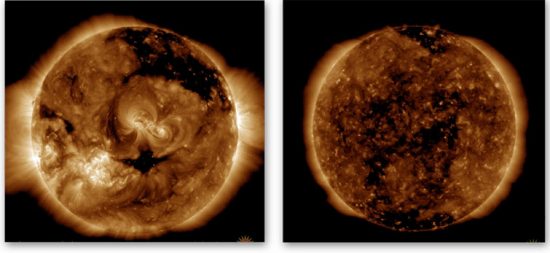
What we can assume, however, is the observation from nuclear weapons tests that solar energy arises from the fusion of hydrogen to form heavier elements. On the other hand, it has also been shown that the fission of heavy elements such as uranium is also an exothermic process. As a result, there must be an energy sink between hydrogen and uranium for the binding of the core building blocks, where the fusion no longer supplies energy, but the ratios are reversed, so that further fusion requires energy. The sun is not an atomic bomb made of hydrogen and helium, otherwise it would have exploded long ago. The fuel hydrogen must therefore be continuously supplied from outside in small amounts, as is also our earthly experience in the energy industry. A look at the X-ray image of the sun confirms these considerations.
Quantum mechanics is essentially a theory of probability. Probability sSee Figure 3. X-rays are produced in two ways: Firstly by bremsstrahlung of decelerated electrons and secondly by nuclear reactions. As a result, we watch the nuclear fusion directly in the X-ray image of the sun. Where the brightest structures are, the most active zones of the fusion are to be expected and consequently also the areas where the strongest solar wind comes from. These are not the polar regions, but neither are the coronal holes, because they were viewed as particularly permeable to a solar wind when it was thought that the solar wind came from inside the sun.
Let us now consider the atomic structure. We know about the free neutrons from nuclear fission processes that they are unstable and that half of them decay within a quarter of an hour. It has therefore been assumed that neutrons must be present in every atomic nucleus.
Conversely, we have to assume that the neutrons in the newly formed atomic nuclei are created from protons and “core” electrons, but protons and core electrons are likely to remain as structures within the nucleus, otherwise the beta decay of radioactive elements and its continuous energy spectrum incomprehensible. Since this is not compatible with the picture of quantum mechanics, Wolfgang Pauli invented the ominous neutrino, which one later also wants to have proven and what the energy is supposed to transport from inside the sun. The many experiments in particle physics have shown, however, that there are only two stable particles, the proton and the electron. That, in turn, does not agree with the dogma of symmetry in particle physics.
But let’s forget about particle physics for a moment and return to our knowledge of electrodynamics. We know that any transformer emits electromagnetic waves when it is energized. The Tesla transformer is an impressive example. A transformer has a ferrite core and two different current loops that differ in the number of turns. If we now imagine this transformer reduced to the size of an atom, then we identify one current loop as the electron shell and the other current loop as core electrons. The protons then stand for the ferrite core. Once we move to this level of abstraction, we can refine our atomic model further by applying James Clerk Maxwell’s laws consistently. We than understand the electron and the proton as a closed vortex each. When two proton vortices are connected by an electron vortex, we get a bipolar elementary magnet. From these bipolar magnets we can build a number of stable isotopes. We identify this building block as a deuteron. However, there are also other elementary building blocks such as the neutron, the tritium nucleus, hereinafter referred to as the triteron (an electron vortex penetrates 3 proton vortices) and the alpha particle, consisting of a quadruple, emerged from two entangled deuterons. Now the atoms are not elementary magnets with a firm shell, so that a balance has to be established between the packing density and the dipole behavior of the elementary magnets. As a result, not all even-number elements are stable. The first time this occurs with 4Bor and the second time with 18Flour. But with deuteron and triteron you can basically assemble all elements.
What do we learn from the solar model in the laboratory?
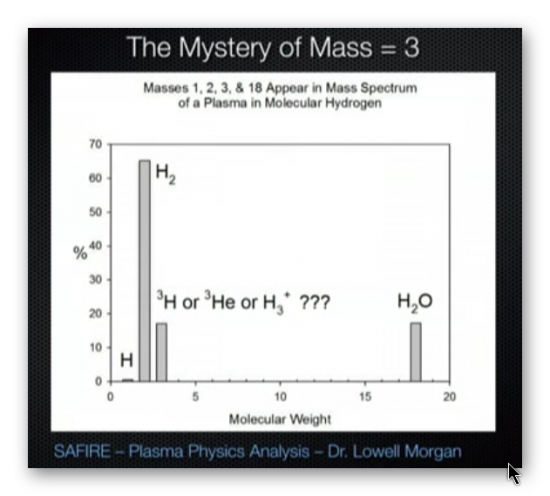
According to Montgomery Childs8 nuclear transmutation requires a catalyst, but he has not said anything about it. During the experiment, there were obviously traces of water or oxygen in their gas mixture of hydrogen and nitrogen , as revealed in a mass spectroscopic gas analysis from 20159. We know about water that it can form double layers.10 (Diagram 4) The diagram does not reveal the ratio of hydrogen to nitrogen. Whether molecules were actually analyzed in the mass spectrometer cannot be traced, as these were safely broken down into their components in a plasma. The mass number 2 could be deuterium or the hydrogen molecule. The mass number 3, however, speaks more for a hot plasma, since super-heavy hydrogen is an isotope that only occurs in traces in nature. Here it is a clear indication of a fusion plasma. The mass number 18 indicates the water molecule or the oxygen isotope 18. That depends on the temperature and the field strength at the measuring point. The nitrogen proportions are not shown in the diagram, which is why there is no reference point in this diagram. However, no further data was disclosed, such as the measurement log of the gas analysis. However, these are the key to the Stellar Atmospheric Function In Regulation Experiment. Only the elements thus obtained were announced in the 2019 update and reference was made to the fact that these results were obtained from an independent body. Details were withheld to protect commercial interests, Childs said when asked.11
The X-ray image is created by bremsstrahlung of the electrons and by nuclear transmutation. This means that the electrons move towards the sun and are slowed down there. The proton current does not come from inside the sun, because the nuclear transmutation happens in the bright zones between the lower corona and the chromosphere. This is where the PN junction is located. The protons are supplied by the hydrogen of the environment. A lot of free hydrogen in molecular form has been observed in active galaxies between the stars. In addition, nitrogen and oxygen also occur. The hydrogen atom consists of a shell electron and an electron. While the electrons of the hydrogen can pass the PN layer, some of the protons are thrown back and registered as solar wind on Earth. The remaining protons condense with the electrons in the zone with the steep temperature gradient to form larger atoms, releasing entropy and precipitating on the sun. Which elements arise in this process can be read from the Fraunhofer lines. This process is thermodynamically analogous to the condensation processes on earth, except that the initial temperature is several orders of magnitude higher and the excess electrons are sucked off by the solar anode in order to fill the electron shells of the newly formed elements.
In any case, if some of the electrons in the atomic nucleus of heavier elements disappear during the fusion of hydrogen, an electron deficiency must arise and the sun as a whole must receive a positive charge. The electrons are brought by the molecular hydrogen, which is attracted to the sun due to its dipole structure and is deprived of its electrons at the threshold from the corona to the chromosphere. This accelerates some of the protons in the direction of space. The protons that enter the chromosphere experience a temperature shock and the electrons present on the double layer get between two or three protons, which now crash against each other as a result of their strong deceleration. The electron is trapped between the protons and becomes a core electron. The result of this extreme drop in temperature is a deuteron, an elementary magnet, or a tritium nucleus, as Figure 4 suggests, whereby neutrons seem to be extremely rare. These building blocks are elementary magnets that attract each other and clump together to form larger cores. A considerable part of the electrons is used to build the nucleus. Only then is the electron shell slowly filled up. The lack of electrons due to nuclear fusion makes the sun a positively charged anode.
What does thermodynamics say about it? The second law of classical thermodynamics says that entropy grows in a closed system. Entropy is the expression for the energy that cannot be used in a Carnot process and that is converted into heat. This cycle is a thought experiment that is used to create a reversible heat and power machine to convert heat into work. He laid the foundation for thermodynamics. If you generalize this process of energy conversion, then entropy is always the energy that can no longer be used by any system. But what is warmth? Ludwig Boltzmann established the connection between entropy and statistical mechanics and expressed temperature in terms of the speed of the atoms. However, when charges move, i.e. ions, electromagnetic radiation is created, says James Clerk Maxwell. But thermal radiation is electromagnetic radiation. Now we have a gap in our understanding.
But why do neutral atoms also generate thermal radiation? Very easily! Neutral atoms are not as neutral as we thought. Between the shell and the core there are always possibilities of displacement, which makes it possible for the atoms to exert forces on one another and these forces are caused by the different charges between the protons and electrons. Ultimately, gravitation is also due to the shifting of charges within the atoms.
On the other hand, if we have identified heat radiation and atomic movement as entropy in heat and power coupling, we can extend this law to shorter electromagnetic waves and we recognize that in an open system the entropy has to be dissipated if an order is to arise. This applies to power generation, charge separation, in power plants, as well as to the construction of a crystal lattice and also to nuclear fusion. Entropy has to be dissipated everywhere so that order can arise. The excess energy must be dissipated in the form of electromagnetic radiation. This is also the reason why a space probe burns up when it enters the earth’s atmosphere and an atom emits radiation when a shell electron jumps onto a low orbit. When an electron is drawn into the atomic nucleus, a particularly large amount of extremely short-wave radiation energy is emitted. The atomic nucleus is rebuilt, which also involves the rebuilding of the atomic shell. This binds electrons. In order to set such a process in motion, the hydrogen atoms must be braked strongly in an electric field and the electrons from the atomic shell sucked out. As a result we get protons with a reversal of direction. These react with the hydrogen atoms and molecules flowing in. We can measure the remaining protons as solar wind on Earth.
Before the third phase began, I had the opportunity at the EU2017 as a volunteer and the only German participant at this conference to speak personally with Monty Childs about his third phase and also with Edwin Kaal about his structured atomic model.9
Current large-scale nuclear fusion experiments are designed in such a way that they attempt to bring a hydrogen-helium mixture under high pressure to very high temperatures without a nuclear fusion occurring. The reason is: The electrons from the atomic shell prevent this. The experimental set-ups are designed in such a way that one tries to create a closed system so as not to lose any heat. But nuclear fusion means building order. The total entropy must be negative12. The following must apply: dSsystem <0, dSext <0, | dSext | > dSint. The SAFIRE experiment works because the remaining electrons are sucked off by the anode, while the ions cannot pass the anode and are therefore strongly decelerated beforehand, just like on the sun. All other fusion experiments always added entropy by only heating the plasma.
But what happens to the solar wind under the influence of an active sun? Light elements fuse, releasing energy and heavy elements disintegrating releasing energy, as the practice of atom bomb tests shows. But there is no explanation why this is so. We know, however, that the point of transition can be found with iron. In astronomy one speaks of the metallicity of the elements. This increases with the age of the stars. We know metals are good conductors of electricity. This is due to the good mobility of the electrons across the boundaries of the individual atom.
What happens now under pressure inside a celestial body with high metallicity? We know how pressure sensors work. Their resistance decreases with the pressure. That should also happen inside a cooled celestial body. The electrons are literally squeezed out. But when there are fewer electrons, the distances between the atoms become smaller. This can promote the fusion of the atomic nuclei to form heavier elements. However, this reaction is endogenous. It needs the external pressure, which increases with the depth. This causes a potential difference between the inside and the outside of the star. The result is an upward convection of the lighter materials. On earth we observe this as volcanism at certain hot spots. This potential difference also causes the magma to break through the surface from time to time. These phenomena are likely to run similarly on the sun. There we call such phenomena flares (torches). With such a charge equalization between the interior and exterior of the celestial body, not only protons, but often also large amounts of other material are thrown out of the liquid solar surface into space. They are incorrectly referred to as coronal mass ejections CME, even though the masses cannot come from the thin corona atmosphere. If you place the optical image with the sunspots over the X-ray image, you can see that there is an active fusion zone over the sunspot. The kinetic energy released can locally accelerate and strengthen the solar wind over the sunspots. See figure 5.
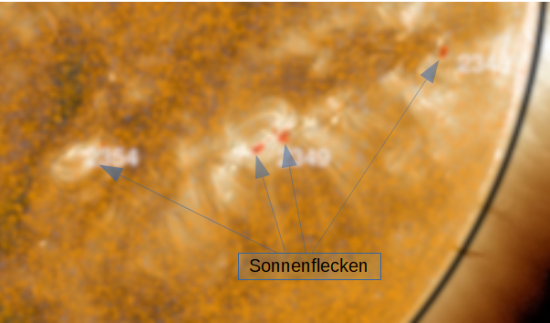
If we compare the conventional thermonuclear model with the electrical model, we must conclude that light elements cannot be incubated inside the sun because the shell electrons would not disappear there, which is possible with elements with a high level of metallicity. If one takes into account the laws of electrodynamics and thermodynamics, one comes to the conclusion that the radiant energy of the sun comes from the double layer between the corona and the chromosphere. It is the nuclear fusion battery for our planet. The SAFIRE experiment has shown that it is possible to technically replicate such a battery. In this respect, I do not expect any spectacular novel results from the Parker probe. However, I expect reliable measurement data on the solar wind from various distances from the sun.
I only fear that the astrophysicists will try again to fit the results into their old solar model. Franklin D. Roosevelt already said: “People are not prisoners of their fate, only prisoners of their thoughts“.
NOTES
1 Sarah Perdue, University of Wisconsin-Madison, April 15, 2015
Phys.org – New research helps explain why the solar wind is hotter than expected
2 Eugene Newman Parker – Conversations on Electric and Magnetic Fields in the Cosmos (Princeton, 2007)
3 DSCOVR (Deep Space Climate Observatory) orbits about 1 million miles (1.5 million kilometers) from Earth. Positioned between the Sun and Earth, this location is called Lagrange point.
4 Ralph E. Juergens “Stellar Thermonuclear Energy: A False Trail?”, Kronos Vol. IV:4 (Sum 1979), pp. 16-25; plus Editor’s Note by L. M. Greenberg, pp. 25-27. and “The Photosphere: Is it the Top or the Bottom of the Phenomenon We Call the Sun?”, Kronos Vol. IV:4, (Sum 1979), pp. 28-54.
5 Montgomery Childs – SAFIRE Project Update 2019
6 Donald E. Scott – “The Electric Sky”
7 H. H. Voigt – Abriss der Astronomie
8 Montgomery Childs – SAFIRE Project Update 2019
9 Montgomery Childs – SAFIRE Project Update 2015
10 Gerald H. Pollack – The Fourth Phase of Water
11 See the Pattern – “EXCLUSIVE – SAFIRE Contacted me in RESPONSE to my REACTION video to ANSWER MY QUESTIONS”
12 Mathias Hüfner – Modern Astrophysics meets Engineering: The Reformation of Physics

Mathias Hüfner is a German volunteer of The Thunderbolts Project. He studied physics from 1964 until 1970 in Leipzig Germany, specializing in analytical measurement technology for radioactive isotopes. He then worked at Carl Zeiss Jena until 1978 on the development of laser microscope spectral analysis. There he was responsible for software development for the evaluation of the spectral data. Later he did his doctorate at the Friedrich Schiller University in the field of engineering and worked there 15 years as a scientific assistant. Some years after the change in East Germany he worked as a freelance computer science teacher the last few years before his retirement. Since 2015, he runs a German website of the Thunderbolts project http://mugglebibliothek.de/EU and has published a book entitled “Modern Astrophysics Meets Engineering: The Reformation of Physics”.
The ideas expressed in Thunderblogs do not necessarily express the views of T-Bolts Group Inc. or The Thunderbolts Project.












